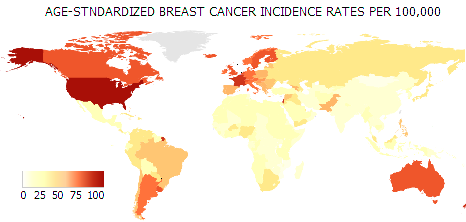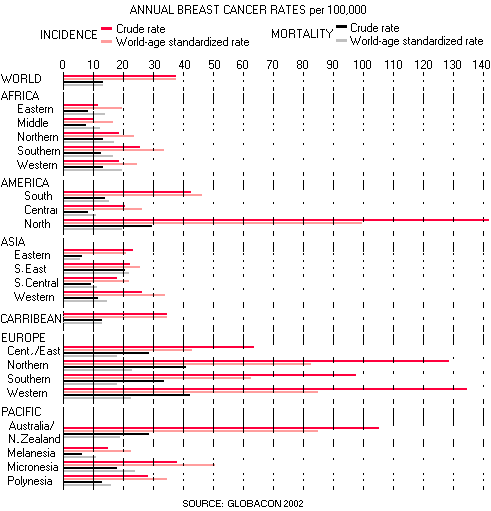|
■
Home ■ site map |
|||||||||||||||||||||||||||||||||
|
BLOG: June 2010 - December 2013 I - Breast cancer risk factors 2. The biggest breast cancer risk factor
Short of relatively rare genetic disorders, the biggest breast cancer risk factor of all, by how much it increases the chances of getting it, is being a middle-age Western female, and particularly U.S. female. It can be noticed right away on the breast cancer incidence map:
Graph bellow shows more specifically how the risk varies in selected world regions in 2002.
Crude rate is the actual rate of incidence. Age-adjusted rate is calculated from the crude rate and population's age, extrapolating statistical value for an average "model population". It cancels out the age differential factor, which puts younger populations at a lesser overall risk from breast cancer (in other words, crude rates may not be directly comparable, due to the population's age bias, while the adjusted rates are). Mortality vs. incidence rates are mainly reflecting quality of health care systems (early detection, treatment) and/or their social availability. Expectedly, relative BC mortality is higher in less developed regions. Wide differences in the rates of incidence, however, indicate that it is environmental exposures, lifestyle and genome that are the major factors in the initiation and advance of breast malignancy. Zooming in on the United States, we see that the incidence rates vary significantly with age and race (sources: SEER-National Cancer Institute, as cited in Opportunities and Strategies for Breast Cancer Prevention Through Risk Reduction, Mahoney et al. 2010). Each year, about 200,000 American women are diagnosed with breast cancer, and about 40,000 die from it. In the U.S. female population (51% of the total of about 300 million, or approximately 153, million), this translates into the overall rate of incidence of about 130 per 100,000, and 26 in 100,000 overall mortality. Again, the more Westernized sub-population, the higher breast cancer incidence. All races have a similar age-related trend, only the magnitude differs. BC incidence peaks between 70 and 80 years of age, but the age-related lifetime risk (U.S. average, SEER 2002-2004) declines toward older age. In other words, women at 60 have much higher BC incidence than women at 40, but due to the fewer years of life remaining, their lifetime risk (LAR) of getting breast cancer is somewhat lower.
Sub-population mortality rates are not directly related to the incidence; as mentioned, it is significantly influenced by social, economic and cultural factors (note that incidence and mortality in two top windows are age-adjusted). Overall, annual mortality from breast cancer is about 40,000 - only about 3.3% of the total U.S. annual female deaths. Nearly as many women die from Alzheimer's disease, and more from each, accidents, cerebrovascular diseases (stroke), respiratory diseases, other cancers, and cardiovascular diseases. The last two are by far dominant, with breast cancer deaths being about 13% of all female cancer deaths (the deadliest being lung cancer, with 26% of all female cancer deaths), and about as much less than female cardiovascular deaths. Considering the numbers, breast cancer is getting much more attention than it should. More so in light of the fact that it's death rate kept stagnant, and started declining in the 90ties, while that for lung cancer rose six fold from the early 60ties, and now is nearly double the breast cancer death rate. One likely reason is that breast cancer is the most common female-specific cancer, enhancing its perceived significance for women. The other, probably more important, that screening for breast cancer was a better money-making opportunity than screening for lung cancer, which would be based on the standard chest X-ray. Studies from the 70's and 80's did find it results in earlier detection and better - e.g. 40% vs. 15%, Sanderson 1986 - 5-year survival (probably due to lead time bias, i.e. the fact that earlier detection prolongs the period between detection and death, even if the time of death doesn't change), but no reduction in mortality. However, these attempts pale in comparison to those invested into finding the rationale for breast cancer screening. But what is it, specifically, that puts Western women in general, and American women in particular, at such a high risk? Data on the change in breast cancer incidence of migrants from low- to high-incidence regions shows that where and how you live matters more than the genome. Asian migrants to the U.S. - Koreans, Japanese, and others - show significant transition toward higher breast cancer rates already in the first foreign-born generation, and the next generation begins to approach the much higher U.S. incidence rates. Not surprisingly, their average estrogen level also increases. Some of the factors protecting traditional Asian populations are obvious: up to several years delayed menarche vs. Western women's, earlier motherhood, more children, more common breastfeeding, lower caloric intake, better nutrient intake, more plant vs. animal foods, higher level of physical activity, and generally lower exposure to environmental carcinogens and estrogen mimics and toxins. The magnitude of some of these factors in Korean women, who still have among the lowest breast cancer incidence rates in the world, is well illustrated by research data (Yoo et al, 2001; cited studies): - having first menstruation before age 14 increases the risk 2 to 2.5 times; menopause after age 50 increases the risk 2-4 times; - not having full-time pregnancy increases the risk 1.5-2.5 times, while postmenopausal women with one or more full-time pregnancy and breastfeeding have the risk reduced 4 to 7-fold It can be assumed that their lower average lifetime estrogen exposure vs. that in Western women must be one of the major protective factors for the traditional Korean women. But it shouldn't be neglected that their kind of diet also promotes better detoxification, including removal of estrogen from the bloodstream. That is one of the benefits of the healthier gut as well. Also, very interesting pattern emerged, linking body estrogen level with early menarche, obesity and late menopause; all three seem to be the result of intensified overall hormonal activity, extending throughout the lifetime (Yoo et al, 1993, 1995). It is widely accepted that the chronically elevated body's natural ovarian hormones level is a potent cancer-promoting factor in Western women. In this context, it comes as no surprise that the above average increase of breast cancer incidence rate in Korean women - higher than in other increasingly westernized Asian countries - has been followed (or preceded) by the significant upward swing in their average size and weight. From 1970 to 1988, the mean height and weight for a 14 year old girls rose from 157cm/40.3kg to 164cm/47.1kg, respectively. Apparently, the advance in body size and weight, result of the more plentiful/caloric diet, indicate that dietary changes are stimulating growth-related hormonal activity, including that of female ovarian hormones. In the process, mean age at menarche in Korea was steadily decreasing, reaching 12.2 years in 1999. That is even slightly lower than in the U.S. (12.8), and significantly below China's figure (17), which was, curiously, the average age at menarche in North America 200 years ago (that is still the average menarche age for contemporary hunting/gathering societies, and probably has been for as far back as it may matter). So there we have it: estrogen exposure for the Western women starts four or five years earlier - which very likely indicates elevated hormonal activity causing accelerated growth and development - while marriage and childbearing are delayed by about as much. This decade, or so, inserted between the time when a girl physiologically becomes woman, and the time of the next natural biological step, the motherhood, significantly increases vulnerability to breast cancer. Not only that life-exposure to estrogen has become a decade longer in Western societies, and that estrogen levels are much higher than before - at least in part due to the "enhanced" diet, high in calories - this extension of time between menarche and full-term pregnancy is placed as the worst possible time in woman's life. The reason is that some breast tissue structures - specifically intralobular terminal ducts - will not fully develop (i.e. differentiate) until after first pregnancy/lactation. Epithelial cells of these structures, on the other hand, have very high rate of proliferation (i.e. mitosis). Both, undeveloped tissues and rapid proliferation, significantly increase vulnerability to carcinogens (estrogen stimulates differentiation, thus taking contraceptives interfering with its normal function can be the added risk before age 20, and possibly before first full pregnancy as well). Combined with the surge in exposures to a variety of carcinogens, with nutritionally depleted, calorie "enriched" diet, and lowered level of physical activity, this had set the stage for the decades long uptrend in breast cancer incidence. The significance of the complex variety of factors related to lifestyle is evident in the gross differences in breast cancer rates in urban vs. rural areas within most countries, particularly those where the contrast between old and new style is the highest. In Korea, the rural Kanghwa county has significantly lower breast cancer incidence than Seoul (12.7 vs. 20.8 per 100,000, Parkin et al. 2005). In Shanghai, China, breast cancer incidence back in 1990s was two and a half times higher in large cities than in more rural Quidong county (27.2 vs. 11.2, Parkin et al. 2005, Chan et al. 2006). Evidently, there is a price to pay for technological and cultural progress. The changing social, economic and cultural patterns following transitions from undeveloped to highly developed societies are not friendly to the female breast. They are accompanied by the continuous increase in breast cancer incidence, culminating, at present, in the Western countries (there are a few exceptions, which will be addressed ahead). Obviously, the biggest single breast cancer risk factor - being a mature Western female - is a very complex one, incorporating multitude of lifestyle and exposure elements. Also, while these are, at present, mainly a concern for the Westerners, they are increasingly becoming relevant for developing countries as well. Some of the major factors contributing to the breast cancer epidemic in developed countries are mentioned above, but there's much more to it. Let's take a closer look at the multitude of factors that, at any moment, and in any woman, can make the difference between staying breast-cancer-free, or having to face the disease. Follows detailed overview of breast cancer risk factors. YOUR BODY ┆ HEALTH RECIPE ┆ NUTRITION ┆ TOXINS ┆ SYMPTOMS |
|||||||||||||||||||||||||||||||||


